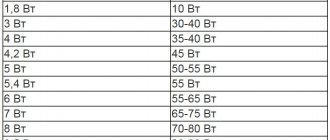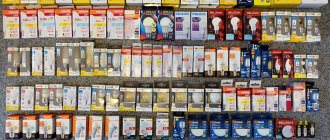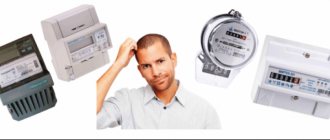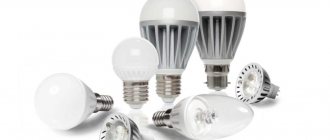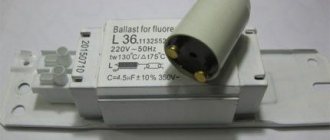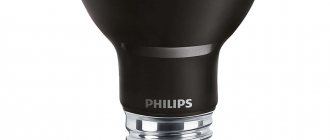It has long been no secret that LED lamps consume much less energy than incandescent lamps. Thus, manufacturers claim that an 8-watt LED lamp produces the same amount of light as a 60-watt incandescent lamp. But in reality, sometimes it turns out that this is not entirely true. The reason is that manufacturers overestimate the real power of LED lamps. That is, that same 8-watt one can actually be an analogue of not 60, but 40 watts. We decided to check whether the information on the packaging should be trusted. We bought 8 different pear-shaped lamps with an E27 base and created a simple test bench. A little theory first, but if you just want results, click HERE.
How is lamp power related to luminous flux?
Strictly speaking, the dependence is almost linear. On average, we can assume that an LED lamp with a frosted diffuser produces 80 Lm (lumens) of light for every watt spent. If we talk about incandescent lamps, they have only 10 lm for this power. That is, a 5-watt LED lamp is actually equivalent to a 40-watt incandescent lamp with a luminous flux of 400 lm.
But the exact numbers are not so important - the important thing is that the relationship is direct. That is, if the lamp has less power than on the package, then it will produce less light. It is difficult to measure the luminous flux without special instruments, but the power is easy. This is what we decided to do with products from 8 popular brands.
Emitter parameters
By studying the parameters of a light emitter, you can determine its capabilities and evaluate how suitable it is for use in certain conditions. Like any device powered by electricity, an LED lamp has its own characteristics. The most important ones to pay attention to include:
- Power . There are two types of it - electric and light. The first means how much energy the lamp will consume during its operation. Its unit of measurement is the watt. The second indicates the amount of luminous flux and is measured in lumens. These two values are invariably related: the brighter the light bulb shines, the more electricity it will consume. On average, to obtain 60 lumens you need to spend 1 watt of energy. The most economical options can produce a brightness of 90 Lm at 1 W.
- Temperature gradation . Defines the light spectrum. Not all types of LED lamps are suitable for home use, but only those that emit in the range from 2700 K (warm glow) to 3500 K (white light).
- Color rendering . Light sources emitting within the same temperature range can produce a variety of color perceptions. Therefore, when conducting tests of LED lamps for the home, you need to pay attention to the transmission index. The higher this coefficient, the less color distortion of illuminated objects occurs. An index of 80-1000 is considered a good indicator.
- Illumination angle . The release of energy in the crystal occurs in beams, so the light emitted by it has a directional shape. In order to illuminate a large area, diffusers are used, and the emitters are placed at different angles relative to each other. The average value of these angles is 120-270°, and the optimal value is 90-180°.
- Base . There are different standards in lighting equipment. In accordance with them, light bulbs are produced for installation in different sockets. The most used are E 14 (minion), E 27, E 40.
- Radiator type . The use of high-power LEDs requires the use of large radiators to effectively remove heat. They are made of aluminum or plastic and can be of different shapes. There are ribbed, smooth, ceramic and composite devices. Plastic has the worst thermal conductivity, while composite is optimal.
You might be interested in this: The difference between white and yellow light
How we took measurements
As a tester, we used the universal Power Meter, which allows us to almost instantly obtain data on the energy consumption of any household appliance. In addition to power consumption, we also simultaneously measured the heating temperature of the light bulb body using an XL830L multimeter, because overheating is one of the most common reasons for lamp failure.
1 of 4
To eliminate the possibility of defects or accidents, we took three copies of each lamp model (8 brands in total). Each was previously operated for 500 hours. You can see the measurement results in our table.
| Model name | Light type | Analog of incandescent lamp power, W | Declared power, W | Measured power, W | Measured case temperature, °C |
| Philips | cold white | 80 | 9 | 10.4 | 65 |
| OSRAM | warm white | 75 | 9 | 9.3 | 82 |
| ERGOLUX | cold white | 80 | 10 | 10.4 | 85 |
| Navigator | cold white | 75 | 10 | 10.3 | 75 |
| Camelion | cold white | 65 | 9 | 8.3 | 72 |
| REV | warm (2700K) | 75 | 10 | 9.2 | 75 |
| ONLITE | cold white | 75 | 10 | 8.4 | 75 |
| Smartbuy | warm | 100 | 13 | 11.0 | 87 |
Testing popular models
Studying the review of diode lamps, we can note ten models that are popular due to their technical characteristics and availability. For the test, we used devices that allow us to monitor product parameters under various conditions - a high-precision multimeter, a stabilizer and a Viso LightSpion meter. The conducted studies showed the following results:
- Eurolamp LED EKO E27 20W A65 (LED-A65−20272 (D)). This lamp is the most expensive of those tested, but its price is fully confirmed by its quality. Has a color rendering index of 92%. The parameters of the emitter exactly correspond to the declared ones. Light pulsation does not exceed 12% and is not visually perceived.
- Maxus A65 12W 4100K 220V E27 (1-LED-564−01) A good light bulb with honest stated parameters at an affordable price. There is practically no pulsation. Color rendering index - 86%. The warranty period is three years.
- Geniled 01210 E27 A60 7W. Great light bulb at a good price. But the manufacturer overestimated the color temperature in the specifications.
- Osram LED STAR CLASSIC A 60 6.8W/827 FR E27. Provides an even glow, but does not work when operating through a switch with neon lighting due to the characteristics of the driver.
- Feron LB-92 25457. For unknown reasons, the light transmission index was below 75%. Otherwise, all characteristics correspond to the declared ones, so a service life of 30 thousand hours is quite likely.
- Philips 871829175275200. A ripple of about 20% was detected in this emitter. Due to the size of the base, or rather its cap, light scatters only forward. Placing the lamp in a chandelier facing upward will result in a loss of brightness.
- BBK MB74C, GU 5.3 (MR16). Properly made heat sink. A good lamp, honest parameters, but a little expensive. Doesn't work with a switch that has an indicator.
- Feron LED LB-159. A very beautiful light bulb in appearance, reminiscent of a burning candle. But with a specified power of 6 W, practical energy consumption was 15% less. Accordingly, the brightness will also be less.
Thus, when comparing LED lamps, you can see that many manufacturers overestimate the parameters of their products. At the same time, the build quality remains at the highest level, so it is not surprising that the lamps last from 3 to 5 years.
LED lamps: leaders and outsiders
Philips
LED lamp : with a declared power of 9 W, it showed a result of 10.4, while heating only to 65°C. Of course, we were surprised by the deviation from the declared value by almost 15% upward, but this is a completely different story - the main thing is that it shines “for all the money” and even a little more.
OSRAM
Review of manufacturers
Many manufacturers around the world are engaged in the production of LED lamps. The bulk are companies from China and Europe. Chinese companies are divided into “semi-basement” and certified. The products of the former should not be considered for purchase, as their use may even be dangerous.
These lamps are assembled from cheap components, and their operation does not meet any standards. The glow of such devices is accompanied by an unpleasant odor and irritating light.
Certified light bulbs undergo quality control and mandatory certification. It is worth noting that many manufacturers are moving their production facilities to China. This is done to reduce the cost of the production process, while the quality of the product remains unchanged. Popular brands include:
- Feron. A Chinese brand distinguished by the variety of appearance of its lamps and their resistance to atmospheric changes.
- Camelion. The products are popular in European countries due to the reliability of the power supplies used in LED emitters.
- Jazzway. A recognized company in the Russian lighting market. During its existence, more than 30 million lamps were produced.
- Gauss. The service life of this brand's products is about 20 years, which is ensured by an automated quality control regime.
- Maxus. The lamps are exceptionally resistant to mechanical damage due to the absence of glass in the bulbs.
- BBK. A Chinese brand that has developed a driver that eliminates ripple and protects the emitter from overheating and voltage surges over a wide range.
- ASD. The company's products are aimed at the Russian sales market. This name is associated with low energy consumption, long service life and safety.
- Osram. A high-tech company from Germany, which is the world's largest manufacturer of LED lamps. Winner of awards for high quality products and innovative developments.
- Philips. The products of the Dutch company are manufactured in China. It is considered a middle peasant among manufacturers with affordable prices.
- Eurolamp. It features a wide range of LED lamps with a well-thought-out cooling system. The German company produces products that meet European standards and are distinguished by affordable prices.
You might be interested in: Features of metal halide lamps
Total: what to buy?
Obviously, foreign brands OSRAM and Philips hold the mark. But the domestic ERGOLUX and Navigator were almost as good as them in our test, and they cost significantly less. Of course, the issue of resource remains open, but even if these lamps last less, the savings will still be noticeable.
This is interesting:
- How to fix an LED light bulb yourself: step-by-step instructions
How does an LED lamp work?
The operating principle of LED lamps is not much different from incandescent lamps. In an LED lamp, many small LEDs and a yellow luminescent layer create the effect of incandescent filaments with almost omnidirectional radiation. Due to their low power consumption, there may be a misconception that LED lamps do not emit heat. In fact, LEDs convert more than 70% of their power consumption into heat, which is significantly less than incandescent bulbs.
Because LEDs use less power, you can touch the dome of most light bulbs when they are on, but the base temperature can reach 85°. After all, most of the heat generated by electronic components is dissipated through the heatsink and housing into the environment.
The best E27 LED fixtures
The market for modern LED equipment is developing very rapidly. Now it is dominated by large and well-established foreign concerns. Newcomers are hot on their heels - actively growing domestic firms and numerous Chinese factories.
Competition in the lighting market
There is a real struggle for the client and each manufacturer is trying as hard as possible to attract users. Some try to interest people with a budget price, others rely on innovative technologies and offer expensive but effective products of impeccable quality.
The classic LED lamp with E27 socket successfully replaces the familiar and traditional Ilyich light bulb. With low electrical consumption, it provides the room with high-quality light that does not tire the eyes
The client is given the opportunity to choose from a variety of attractive offers exactly what best suits his needs and requirements for home lighting systems.
Philips brand LED products
Philips has long held a leading position in the market of LED equipment and related elements. Branded light bulbs marked E27, manufactured at the concern's production facilities in Europe, meet the highest international standards and undergo mandatory certification.
Philips is very careful about the packaging of its products. All lamps that go on sale are packed in boxes made of good density cardboard, which almost completely eliminates the possibility of damage to the integrity of the bulb part during transportation.
Among the main advantages of the product are good economy, record efficiency, and complete environmental safety. And also the presence in the product line of not only products of the usual shape, but also more original types, such as “corn” or “candle in the wind”.
]Philips[/anchor] provides a 2-year warranty on its E27 class products. If something happens to the lamp during this period, it will definitely be repaired or replaced with a new one. To use this service, you need to keep the receipt certifying the purchase and ask the consultant to make a note about the date of sale in the registration certificate or on the lamp box.
Customers who have already purchased the E27 module from Phillips note the heavy weight of the case, high-quality assembly and the absence of unpleasant odors during combustion
The only disadvantage of the product is the high price. However, experts say that this is absolutely justified.
The products operate correctly throughout their entire service life, do not suffer from diode burnout, and by the end of the operational period they practically do not fade, continuing to provide a pleasant, soft, unobtrusive light in the room.
Offers from the Navigator brand
The history of the brand began in 1993 with the formation of the Battery Team company in Russia. As its main area of activity, the new association has chosen to trade in high-quality LED modules and related batteries from well-known global manufacturers.
The Navigator brand plant is located in the city of Klin. Each stage of production is strictly controlled to ensure compliance with technological requirements. This makes it possible to identify a fault long before the product reaches the store shelf, and from there to the buyer
The owners created their own brand in 2006 and introduced users to a line of LED lamps called Navigator. At first, the assortment was meager and consisted of only a few models.
Today the company produces a whole range of products of different shapes and configurations. Most of them have an E27 base and enjoy well-deserved success among consumers due to a reasonable combination of efficiency, cost, excellent characteristics and good light intensity.
Products from Navigator are presented in two series. The Standart line includes simple lamps at a budget price. Professional modules are valued somewhat more expensively, but they make it possible to create a professional lighting system of any complexity in a room
Among the advantages of E27 lamps from Navigator is a pleasant flow of light, attractive design and reasonable price.
The disadvantage is that the radiator heats up too much, causing an increase in power consumption by about 10-15% of the value declared by the manufacturer.
Range of LED products from Osram
The German brand Osram is rightfully considered an old-timer in the market for lighting equipment of various types. Having appeared in 1906, it loudly declared itself, offering customers high-quality, effective, reliable products and has not slowed down since then.
E27 LED modules from the German brand are deservedly popular. They are distinguished from similar products by impeccable build quality, minimal energy consumption, high reliability and no delay in ignition at the moment of switching on.
Now the company operates as one of the many enterprises in the industrial sector owned by the large international concern Siemens. It is one of the three leaders supplying the consumer market with the widest range of the most advanced lighting products.
Osram annually spends 5% of its profits on scientific research and is constantly working to improve the characteristics of diode products.
Osram type E27 devices have undergone expert testing in one of the European research laboratories. This procedure confirmed the good energy efficiency and complete environmental safety of the German brand lamps
The company positions the goal of its work as providing customers with modern, convenient, comfortable, attractive and operationally stable products that can satisfy the most unusual customer needs.
Consumers rate E27 from Osram very highly. The advantages include durability, brightness of combustion and a rich, dense stream of light, scattered throughout the room without flickering or pulsating.
The disadvantages include the not very good location of the markings on the lamp itself. In certain types of chandeliers and lamps it is visible and it spoils the overall interior design.
Popular rulers from Gauss
The Gauss brand is owned by the Russian company. At first, the company specialized only in the sale of LED equipment and related elements made in China.
Own production was organized after 2010, and by 2015 the company’s share in the domestic market of diode light sources was 18%. Today, Gauss products with E27 base are produced in different versions. In the production process, the company uses unique world technologies and its own developments.
Vatron provides a 3-year guarantee for its products. The service life indicated on the packaging is 30 thousand hours or 20 years if used for 5 hours a day
Gauss lamps demonstrate high efficiency and practically do not heat up. This allows them to be used in combination with suspended ceilings, where specific requirements are imposed on the lighting system.
The company's product range includes classic, decorative and mirror LED lamps with E27 socket, as well as dimmable models.
The Elementari line belongs to the budget class. It presents devices with different glow temperatures, a good color rendering index, an operating voltage of 180-240 V and a dispersion angle of 240 degrees. Such products are considered universal and are suitable for both modern and vintage lighting devices.
Users give Elementary models high marks. Most often they praise the rich light output with a low power of the lamp itself, durability, lack of flicker and excellent compatibility with different types of lamps. The disadvantages include incorrect operation of devices with some types of switches.
Gauss E27 lamps are environmentally friendly and do not emit ultraviolet radiation. Thanks to this, they can be screwed into chandeliers, sconces and floor lamps located in children's rooms
The Reflektor series is represented by lamps equipped with glass inside, which acts as a reflector for light and provides a narrow but very bright stream of illumination.
The dispersion angle is 120 degrees. Most often, these modules are used to install spotlights in spotlights, emphasizing certain areas or interior elements. The list of decorative modifications of Gauss E27 includes products of original shapes, for example, “candle in the wind.” They are used in chandeliers and lamps of unusual design.
Comparison of lighting lamps
| Light. flow, lm | Incandescent, W | Luminescent, W | LED, W |
| 250 | 20 | 5-7 | 2-3 |
| 400 | 40 | 10-13 | 4-5 |
| 700 | 60 | 15-16 | 6-10 |
| 900 | 75 | 18-20 | 10-12 |
| 1200 | 100 | 25-30 | 12-15 |
| 1800 | 150 | 40-50 | 18-20 |
| 2500 | 200 | 60-80 | 25-30 |
You can find the most important terms in the glossary below. Manufacturers are required to indicate these values on the packaging.
Essential LED Terms
| Radiation angle (degrees) | The area in which the lamp reaches at least 50% luminous intensity (in candelas). |
| Efficiency (lumens per watt) | Modern high-quality LED lamps reach values above 75 lm/W |
| Color temperature (in Kelvin) | LEDs up to 3300K glow with warm white light (similar to incandescent lamps), up to 5000K - neutral white, starting from 5000K - cool white light. |
| Color rendering index (CRI) | Shows how closely the body color in the light emitted by the lamp corresponds to natural light. Incandescent lamps reach an index value of almost 100 units, modern LED lamps often reach values from 80 to 95. |
| Power consumption (in Watts) | Unlike incandescent lamps, the power of LED lamps does not measure brightness, but only energy consumption. |
| Luminous intensity (in candelas) | The brightness of a light source in a certain direction (spatial angle). |
| Luminous flux (lumens) | Overall lamp brightness. Daylight brightness, depending on conditions, ranges from 250 lm (approx. 25 W) to 1100 lm (approx. 75 W). |
Principle of operation
LED is a semiconductor. When an electric current passes through it, it produces radiation in the visible light spectrum. Physically, it is a crystal in which a pn junction is created. When it is turned on in forward bias, when the plus of the power supply is applied to the hole zone (p), and the minus to the electron zone (n), a movement of charges occurs, which meet each other at the border of the contact zone.
When they collide, a process of recombination (mutual destruction) occurs with the release of energy. This energy forms the light perceived by the human eye. Not all semiconductors can emit in the visible spectrum. Direct-gap semiconductors are considered the best emitters. These include GaAs, InP, ZnSe, CdTe. The light bulb itself consists of several parts, which include:
- Diffuser. Used to create uniform illumination of a large area.
- Primary radiator. A heat-conducting plate in direct contact with the diode emitter.
- Main radiator. Serves to remove heat from both the diode crystal and the electronic board.
- Driver. An electronic circuit that converts the 220 volt network voltage to that required for the operation of the emitter.
- Base. Available in different sizes and designed to create reliable electrical contact.
You might be interested in this How to recycle lamps
The electronic circuit (driver) works on the principle of frequency and voltage conversion. In addition, its main task is to maintain a given current value, while the voltage can vary.
The amount of current depends on the brightness of the LEDs, so the driver must have a power reserve of 25-30%, otherwise the current passing through it will lead to overheating of its components and failure. When reviewing and comparing LED lamps, a lot of attention is paid to the quality of this electronic module.
